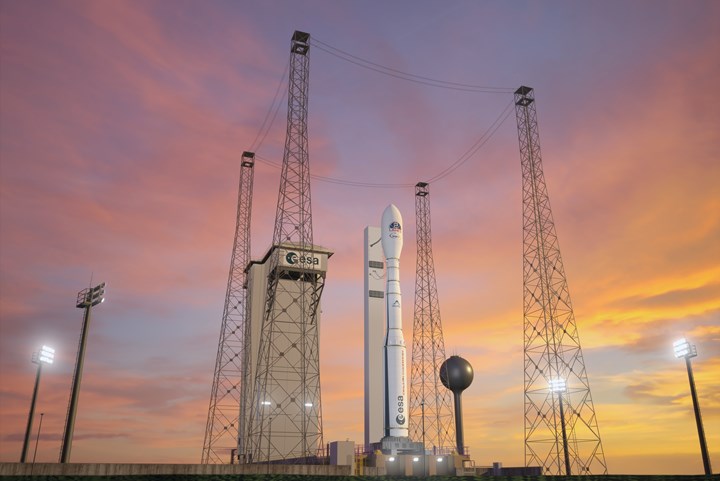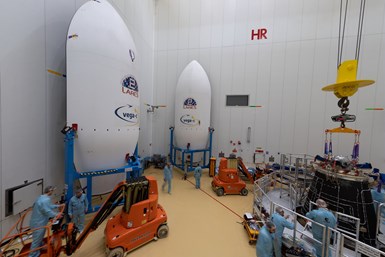Beyond Gravity announces maiden flight of Vega-C rocket, features CFRP composites
Vega-C replaces the current Vega rocket, comprising a CFRP payload fairing and payload adapter system, as well as a more intuitive onboard computer, all of which is produced at Beyond Gravity’s various production sites.
Beyond Gravity (formerly RUAG Space, Zürich, Switzerland) has delivered the composite payload fairing, the top of the new medium-lift European rocket Vega-C, which launches on July 13 for its inaugural flight. Beyond Gravity also produced the launcher computer and the Vampire payload adapter system, the latter of which also uses carbon fiber-reinforced polymer (CFRP) composites.
Vega-C is scheduled to lift off from the European spaceport in Kourou, South America, launching the company’s “LARES 2” Laser Relativity satellite. The spherical satellite enables research into geodynamics and general relativity, Beyond Gravity says.
“The first flight of a new rocket is always a very special moment. We have delivered mission-critical products to the rocket with our payload fairing, our payload adapter system and the launcher’s onboard computer,” André Wall, CEO, Beyond Gravity, says. “Each product is customized for this new rocket and has new, enhanced features.” Vega-C replaces the current Vega rocket.
The top of the Vega-C rocket, the payload fairing, has a new design. “The fairing is larger than the fairing of the Vega rocket and can accommodate an additional payload mass of 800 kilograms,” Holger Wentscher, senior vice president, Launchers at Beyond Gravity, explains. “Additionally, our fairing includes state-of-the-art technologies that make it more versatile than its predecessor.” This also results in reduced launch costs per kilogram, the company says.
The two halves of the Beyond Gravity payload fairings for Vega-C (left) and the “Vampire” payload adapter system from Beyond Gravity (right) in a cleanroom in Kourou. Photo Credit: Beyond Gravity
The ogive-shaped fairing at the top of Vega-C protects the satellites from thermal, acoustic and aerodynamic environment at launch and on the ascent to space. The 9-meter-high fairing with a diameter of 3.3 meters was produced at Beyond Gravity’s site in Emmen, Switzerland. The fairing is made of CFRP composites that were cured in an industrial oven. All payload fairings for any European rocket are said to comes from Beyond Gravity and this production facility.
Vega-C can be used for one, two or more payloads (satellites) per launch. To place a larger single satellite into space, Vega-C uses a payload adapter system called “Vampire.” “We have developed a new design for this adapter, which makes it possible to utilize the maximum performance of the Vega-C launcher. Our adapter makes sure, that the satellite is safely placed into orbit with [the] highest precision,” stresses Wentscher. All payload adapters and separations system from Beyond Gravity are produced at its site in Linköping, Sweden. The Vampire adapter will be used for single large payloads and can be used in combination with smaller payloads on the SSMS (Small Spacecraft Mission Service) multiple payload dispenser.
Moreover, during flight, the Vega-C launcher is controlled by an onboard computer (“brain”) from Beyond Gravity. “We have developed a new and improved version of our onboard computer, which is smaller, lighter and more cost efficient,” Wentscher says. The launcher onboard computer is being built at Beyond Gravity’s site in Gothenburg. Beyond Gravity also provided all computers for the Vega rockets.
Related Content
Bio-based acrylonitrile for carbon fiber manufacture
The quest for a sustainable source of acrylonitrile for carbon fiber manufacture has made the leap from the lab to the market.
Read MoreJeep all-composite roof receivers achieve steel performance at low mass
Ultrashort carbon fiber/PPA replaces steel on rooftop brackets to hold Jeep soft tops, hardtops.
Read MoreCryo-compressed hydrogen, the best solution for storage and refueling stations?
Cryomotive’s CRYOGAS solution claims the highest storage density, lowest refueling cost and widest operating range without H2 losses while using one-fifth the carbon fiber required in compressed gas tanks.
Read MoreInfinite Composites: Type V tanks for space, hydrogen, automotive and more
After a decade of proving its linerless, weight-saving composite tanks with NASA and more than 30 aerospace companies, this CryoSphere pioneer is scaling for growth in commercial space and sustainable transportation on Earth.
Read MoreRead Next
NASA reveals James Webb Telescope’s first images of an unseen universe
The world gets its first look at the full capabilities of the composites-intensive James Webb Space Telescope in space through a series of highly detailed images.
Read MoreVIDEO: High-volume processing for fiberglass components
Cannon Ergos, a company specializing in high-ton presses and equipment for composites fabrication and plastics processing, displayed automotive and industrial components at CAMX 2024.
Read MoreDeveloping bonded composite repair for ships, offshore units
Bureau Veritas and industry partners issue guidelines and pave the way for certification via StrengthBond Offshore project.
Read More




























